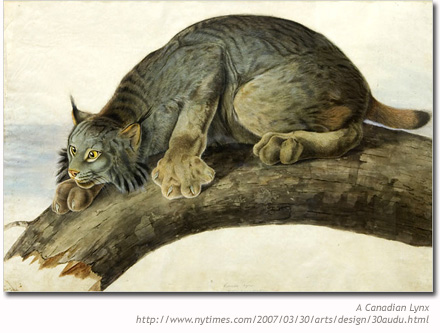Audubon’s Paintings and Watercolors Featured in Two New York Exhibits
by admin ~ April 2nd, 2007

Two exhibits open in New York featuring the prolific work of Victorian Era painter and naturalist John James Audubon. His stunning images were created from stills of birds and animals obtained in the wild, and differed from his contemporaries by being situated in their native habitat and in naturalistic poses. Audubon followed in the footsteps of Benjamin Franklin, as one of the early Americans elected a fellow of the London’s Royal Society. Born in Haiti, he came to natural history out of necessity, following the failure of several business ventures in Pennsylvania and Kentucky. He traveled widely with his prints and displays speaking to audiences about his technique of preparing and displaying birds, his ambition to survey and document wild lands, and seeking to raise money for his natural history expeditions and the publication of his works. The American Museum of Natural History exhibit, “The Unknown Audubons,” focuses on the last of his expeditions by steamboat up the Missouri River in 1843 with his son (a route traveled just 40 years earlier by Lewis and Clark). The trip resulted in numerous oils, watercolors and hand-colored lithographs, which formed the heart of his last great work: “Viviparous Quadrupeds of North America” (1845-1848). The companion exhibit at the New York Historical Society, “Audubon’s Aviary,” features paintings and various multimedia displays including birdcalls and other media highlighting Audubon’s life, art and times. Both exhibits feature conservation and Victorian Era scientific goals as their focus. For more on Audubon’s life and times, there are any number of good books and biographies, including “Audubon’s Elephant,” by Duff Hart-Davis, and “Under a Wild Sky,” by William Souder.
.jpg)